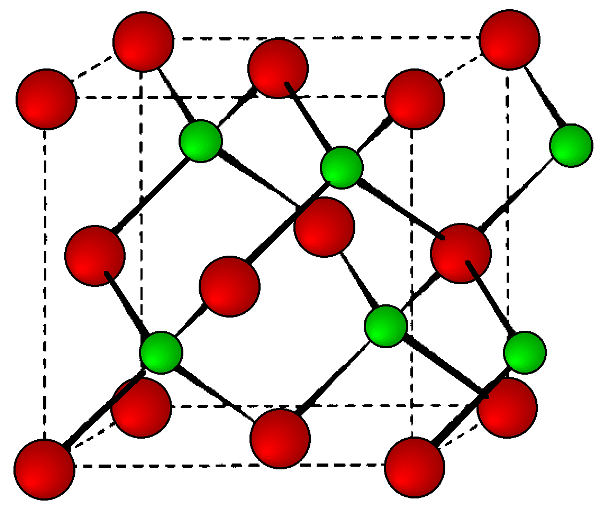| << Chapter < Page | Chapter >> Page > |


| Compound | Structure | Lattice parameter (Å) | Density (g/cm 3 ) |
| AlN | wurtzite | a = 3.11(1), c = 4.98(1) | 3.255 |
| AlP | zinc blende | a = 5.4635(4) | 2.40(1) |
| AlAs | zinc blende | a = 5.660 | 3.760 |
| AlSb | zinc blende | a = 6.1355(1) | 4.26 |
| GaN | wurtzite | a = 3.190, c = 5.187 | |
| GaP | zinc blende | a = 5.4505(2) | 4.138 |
| GaAs | zinc blende | a = 5.65325(2) | 5.3176(3) |
| InN | wurtzite | a = 3.5446, c = 5.7034 | 6.81 |
| InP | zinc blende | a = 5.868(1) | 4.81 |
| InAs | zinc blende | a = 6.0583 | 5.667 |
| InSb | zinc blende | a = 6.47937 | 5.7747(4) |

The homogeneity of structures of alloys for a wide range of solid solutions to be formed between III-V compounds in almost any combination. Two classes of ternary alloys are formed: III x -III 1-x -V (e.g., Al x -Ga 1-x -As) and III-V 1-x -V x (e.g., Ga-As 1-x -P x ) . While quaternary alloys of the type III x -III 1-x -V y -V 1-y allow for the growth of materials with similar lattice parameters, but a broad range of band gaps. A very important ternary alloy, especially in optoelectronic applications, is Al x -Ga 1-x -As and its lattice parameter ( a ) is directly related to the composition (x).
a = 5.6533 + 0.0078 x
Not all of the III-V compounds have well characterized high-pressure phases. however, in each case where a high-pressure phase is observed the coordination number of both the group III and group V element increases from four to six. Thus, AlP undergoes a zinc blende to rock salt transformation at high pressure above 170 kbar, while AlSb and GaAs form orthorhombic distorted rock salt structures above 77 and 172 kbar, respectively. An orthorhombic structure is proposed for the high-pressure form of InP (>133 kbar). Indium arsenide (InAs) undergoes two-phase transformations. The zinc blende structure is converted to a rock salt structure above 77 kbar, which in turn forms a β-tin structure above 170 kbar.
The structures of the II-VI compound semiconductors are less predictable than those of the III-V compounds (above), and while zinc blende structure exists for almost all of the compounds there is a stronger tendency towards the hexagonal wurtzite form. In several cases the zinc blende structure is observed under ambient conditions, but may be converted to the wurtzite form upon heating. In general the wurtzite form predominates with the smaller anions (e.g., oxides), while the zinc blende becomes the more stable phase for the larger anions (e.g., tellurides). One exception is mercury sulfide (HgS) that is the archetype for the trigonal cinnabar phase. [link] lists the stable phase of the chalcogenides of zinc, cadmium and mercury, along with their high temperature phases where applicable. Solid solutions of the II-VI compounds are not as easily formed as for the III-V compounds; however, two important examples are ZnS x Se 1-x and Cd x Hg 1-x Te.

Notification Switch
Would you like to follow the 'Physical methods in chemistry and nano science' conversation and receive update notifications?